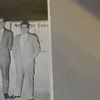Disclaimer
This entry contains information known to us from a variety of sources but may not include all the information currently available. Please be in touch if you notice any inadvertent mistakes in our presentation or have additional knowledge or sources to share. Thank you.
Archive
Jewish Recreation Club, Khartoum, Sudan
The Jewish Recreation Club in Khartoum was where men would go to play tawleh, women would play cards, and youth would play basketball. It was down the block from the Coliseum Cinema, and not far from the synagogue and Comboni College. It was also known as the “Jewish Social Club.” Community events were held here; it was an open-air place with mostly no roof.
Description
A HISTORY OF JEWS IN THE SUDAN
Jewish history in the Sudan can be traced back to a small community formed in the late nineteenth century [2]. There were eight Sephardic families living in the Sudan under Turkish and Ottoman rule [2]. It is unknown how these families originated in the Sudan; however, they were free to practice Judaism throughout the mid-to-late 1800s until Ottoman rule was overthrown and the Sudanese Mahdiyya was established in 1885 [1]. Under Mahdist rule, the Sudanese Jewish community was forced to convert to Islam under threat of death [1]. In 1898, the British claimed the Sudan as a colony, opening up new trade and travel opportunities that brought more Jews into the country [2].
After British rule had been established, the eight Jewish families reverted to Judaism and were quickly joined by more Jewish families seeking new economic opportunities in the Sudan [3]. Many Jewish textile and silk merchants from all over the Middle East and North Africa settled along Nile River towns.
In 1926, the community opened a synagogue on a central street in Khartoum. The Jewish community of the Sudan was overseen by the Egyptian Beth-Din (Jewish law courts) and the Moroccan Rabbi Malka. Between 1930 and 1950, the community reached its peak membership, with 250 families totaling around 1,000 Jews [4]. Though the community was spread out across four towns, it was tight-knit and centered around the synagogue in Khartoum.
The Sudan gained its independence in 1956; however, the Suez Crisis later that year contributed greatly to a rise in antisemitism. As antisemitism intensified, many community members began to leave the Sudan for Israel, the United States, the United Kingdom, and Switzerland [6]. Much of the community had left by 1960. In 1967, Jewish men were arrested en masse, and Sudanese newspapers advocated for the arrest and torture of Jewish community leaders [6]. Jewish emigration intensified, and the last members of the Jewish community left Sudan in the early 1970s [5].
DESCRIPTION
The Jewish Recreation Club started in the 1940s as a sports club for young Jewish men in their teens and twenties [1]. In 1928, the community rented spacious grounds for their successful soccer club on Victoria Avenue, located near the synagogue and Comboni College. A tennis court and small rooms were constructed, but in the late 1930s, the grounds were sold to a Cinema. The community purchased a large lot two blocks behind the Khartoum Synagogue, and the Jewish Recreation Club was established. It was equipped with a large open-air dance floor, meeting rooms, and a cafeteria kitchen. Adjacent grounds were also rented for more sports fields, including a basketball court [9]. Most of the club operated outdoors.
The club became a meeting place for Khartoum’s Jewish families, many who used it nightly. They would play card games, ping-pong, backgammon, or socialize over drinks. The club would host an Annual Jewish Community Ball, a successful fundraising event often attended by members from other expatriate communities [10].
Though the Jewish community in the Sudan was one of the smallest in the Middle East and North Africa, it was close-knit and members were very active. Women would often cook together for large community gatherings. The club was a pleasant and enjoyable social space for the entire Sudanese Jewish community [5].
Sources
[1] Castellino, Joshua, and Kathleen A. Cavanaugh. Minority rights in the Middle East. OUP Oxford, 2013.
[2] Omer, Ibrahim M., Jewish Magazine. “Ottoman Jewish Community of Sudan.” Editor, Jewish Magazine, n.d. http://www.jewishmag.com/138mag/jews_ottoman_sudan/jews_ottoman_sudan.htm.
[3] Copyright 2023. “Sudan Virtual Jewish History Tour,” n.d. https://www.jewishvirtuallibrary.org/south-sudan-virtual-jewish-history-tour.
[4] Tales of JewishSudan. “History | Tales of Jewish Sudan,” n.d. https://www.talesofjewishsudan.com/history.
“Sudan’s Lost Jewish Community - Sudan Memory,” n.d. https://www.sudanmemory.org/cms/105/.
[5] ABBOUDI, DAISY. “The Secrets of Sudan’s Jews.” The Jewish Chronicle, December 30, 2016. https://www.thejc.com/news/world/the-secrets-of-sudans-jews-1.430902.
[6] Kushkush, Isma’il. “Sudanese Jews Recall Long-Lost World with Nostalgia.” Times of Israel, January 26, 2017. https://www.timesofisrael.com/sudanese-jews-recall-long-lost-world-with-nostalgia/.
[7] Schwartz, Yaakov. “Exiled Jews Would ‘Love’ to See Sudan Again, If given Chance via New Israel Ties.” Times of Israel, November 1, 2020. https://www.timesofisrael.com/exiled-jews-would-love-to-see-sudan-again-if-given-chance-via-new-israel-ties/.
[8] Malka, Eli S. "Jacob's Children in the Land of the Mahdi: Jews of the Sudan." (1997).
[9] Aboudi, Joseph “Sudan Interviews,” by Diarna Volunteer, 2015.
[10] “Sudan’s Lost Jewish Community - in Pictures.” BBC News, October 20, 2019. https://www.bbc.com/news/world-africa-49728912.
[11] ISMAIL KUSHKUSH The Associated Press. “Stories of the Sudanese Diaspora.” Arkansas Online, February 4, 2017. https://www.arkansasonline.com/news/2017/feb/04/stories-of-the-sudanese-diaspora-201702-1/.



